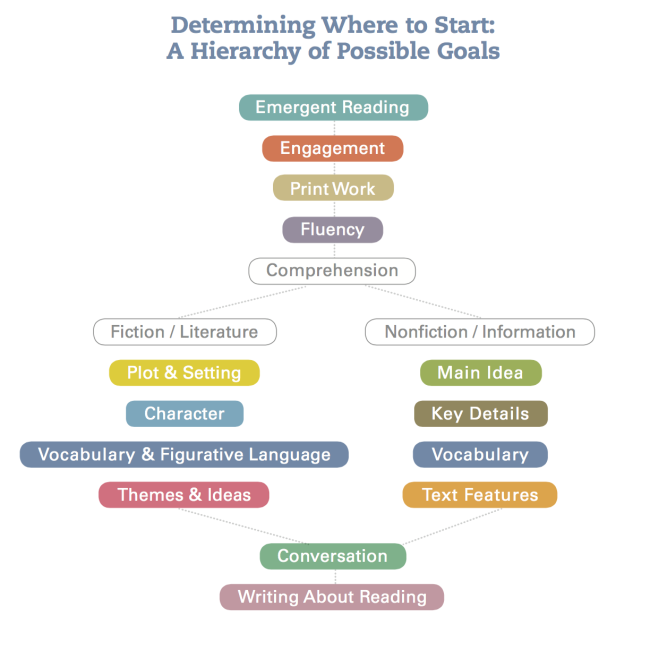Tags
Supporting Independent Readers and Independent Reading by Jennifer Serravallo
Remember when independent reading was called DEAR? Or SSR? Or SQUIRT? (Or maybe I am the only one with that last one? It stands for Sustained Quiet Uninterrupted Reading Time). Acronyms aside, it looked like this: Kids chose whatever they wanted, teachers sat their desks to get through the paperwork that was piling up, or, maybe, to read at their own desk while students read at theirs. Those days, independent meant really independent.
At some point, there seemed to be many who said, “Wait a minute. Can we really trust that this independent reading time is worth it? What if they aren’t really reading? What if they aren’t really understanding?” Some got rid of independent reading. Others adopted quizzes and computer-based solutions to try to address this “problem.”
Please, please, please. Enough with the multiple choice quizzes. There are other ways to check in with readers in ways that holds them accountable while also supporting** them and making them more excited about reading. Instead of outsourcing this to a computer program, teachers can regard independent reading time as instructional time.
Support Readers By Sharing Your Love Of Reading and Excitement About Books
Many teachers book talk with their whole class, which I think is a great practice to generate buzz in your larger community. I also like to pull small groups of students together to do book talks on books I think they’ll not only love but that also are ones that won’t be too challenging for them, since I know that within any whole class there are likely to be a wide range of abilities. I also encourage children to book talk favorites with their peers.
Support Readers by Helping Them to Set Goals
Another type of conversation I have with students during independent reading is around what they hope to accomplish as readers. I call these “goal-setting conferences.” Undirected and unsupported, students will usually say something vague such as “I want to read more” or “I want to read harder books.” To help these goal-setting conferences be as productive as possible, I’ll grab an artifact of their learning ahead of time—a notebook entry, a transcript of a recent conversation, a running record—and use the work sample to lead them in a discovery of what sorts of work they might take on that will help them get more from their reading. Every student will identify one of 13 possible goals, ranging from engagement to print work, fluency to themes and ideas. If there is more than one area we agree they could use support with, we’ll start at the top of the list, spend a few weeks on it, and then work our way down.

from The Reading Strategies Book by Jennifer Serravallo ©2015 (Heinemann, Portsmouth NH)
Support Readers by Asking Good Questions
During independent reading, I think it helps if the teacher is up and about the classroom, sometimes conferring with individuals and sometimes conferring with small groups. I ask questions to discover how they are interacting with their choice of text, and I offer support to help them get more out of it. The questions I ask will usually match the goals we’ve decided on during goal-setting conferences. So, if a student is working on engagement and book choice I might ask, “What books have you read lately that you’ve loved? Which did you abandon?” If the student is working on a goal of studying characters, I might ask, “Tell me about your main character. What are you learning/thinking about him/her?” and if a student is thinking about themes and ideas I might ask, “What lessons are you taking away from the book so far?”
Support readers by giving them strategies
The conversations I have with readers during independent reading around their goals helps me focus my instruction on what each reader needs most. I’ll offer strategies that connect to the goal they’ve decided they want to work on. For instance, if a student is practicing studying characters, I won’t just say “Keep thinking about your characters and keep track!” but instead I’ll offer a specific step-by-step way to do it such as, “Notice where a secondary character interacts with a main character. Think about what that tells you about their relationship. Think about ideas you have about each one of them as individuals, and what you think of their relationship.”
The idea with all of this support in class is to set students up for a hearty, healthy, independent reading life outside of school, too. Maintaining a regular conferring practice where I equip children with goals and strategies they can learn to practice independently, and ensuring they are set up with books they are going to love are just a few ways I rely on most. How do you support your readers’ independent reading?
**I’m certainly not alone in the idea that independent readers need support. For a great, succinct volume of research I’d recommend you take a look at Miller and Moss’s No More Independent Reading Without Support. Moss and Young’s more in-depth look at research is Creating Lifelong Readers Through Independent Reading. And if you really are in the mood for research, check out Revisiting Silent Reading: New Directions for Teachers and Researchers edited by Hiebert and Reutzel (2010)
Jennifer Serravallo is a literacy consultant, speaker, and the author of the popular Heinemann titles The Reading Strategies Book, The Literacy Teacher’s Playbooks, Teaching Reading in Small Groups and Conferring with Readers. She is also the creator of the two-time award-winning Independent Reading Assessment Series. She was a Senior Staff Developer at the Teachers College Reading and Writing Project and taught in Title I schools in NYC. Tweet her @jserravallo.


Thanks for sharing these great ideas. I’d like to help my children deepen how they read their books. My daughter attended her first book club meeting this week. This was put on by our local bookshop and they take the kids to a cafe across the road where they talk about the book. She really enjoyed it and I also thought she’d enjoy hooking up with some other keen readers. I snuck a peak at them and they all looked so grown up even though they were primary schoolers around 9-12 years old.
xx Rowena
A book club for primary kids? How wonderful!
I was pretty stoked they have one and it’s just down the street…brilliant!
This is great- I had totally forgotten about ssr. I want this to be a daily activity for me.
Yes, yes, and YES!!!!
This is great advice for teachers. Sadly, my daughter’s school is one of the multiple choice testers, and that’s how the teacher determines reading groups and levels. I volunteer in the classroom, and find it frustrating that most of the time, the kids understood the content of what they read, but not the questions asked. If I re-word a question, they usually can give me the correct answer, but if they’re testing on the computer, no one is there to ask the question in a different manner.
Have you described your observation with the teacher? A teacher might realize the need to teach the academic vocabulary used in questions and/or the need to teach students how to parse questions to figure out what type of thinking questions are asking for.
Awesome ideas! Thanks for sharing!
LOVED this post!!
When I taught 3rd and 4th grade we called our independent reading time FRED … Friends Read Every Day 🙂 This was my favorite time of the day and I did it for the first 20 mins. of our reading workshop so that I could take the time to confer with my students. I loved it because it made me read the same books that they were reading … it gave me a new perspective of what they were interested in and what I needed to teach for in guided reading and book club.
Thanks Jennifer for this reminder of who important independent reading time is 🙂
Jennifer summarized her brilliant book, The Reading Strategies Book, a must have for every K-5 teacher!!
SQUIRT?
Love the hierarchy – this is a great place for teachers to start when they feel like they don’t even know where to begin.
Well said. I appreciate your sharing and suggestions. I am saddened by the removal of DEAR in too many classrooms. It is a time for students to discover and learn about their passions.
Super helpful in bridging the gap between what I’m doing and what will be more beneficial for my students–thank you!
Really enjoy the input. Teach reading k to 5. Big span. Thanks for the tips!!
Jen- This is a helpful compilation of ways that teachers can support independent reading. Thank you for sharing your thoughts!
I am not a teacher and trying to distinguish what is age appropriate for a first grade class with independent reading. my son’s class is two months into the year and they are doing two sessions a day, the first is 30 minutes and the second is 25 minutes. There are many ell students in the class so i know this time is useful to the teacher to work with all of the children. what kind of questions can i be asking to ensure that this is a appropriate expectation of them? the other first grade class is only at a 15 minute session. Grateful for any expertise and advice on the matter as we want to ensure our son and the other kids are building a love of reading.